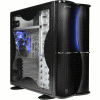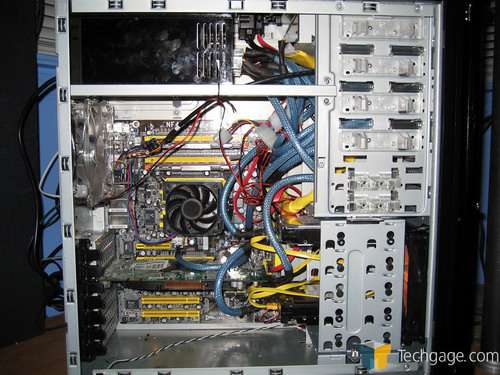- Qualcomm Launches Snapdragon 4 Gen 2 Mobile Platform
- AMD Launches Ryzen PRO 7000 Series Mobile & Desktop Platform
- Intel Launches Sleek Single-Slot Arc Pro A60 Workstation Graphics Card
- NVIDIA Announces Latest Ada Lovelace Additions: GeForce RTX 4060 Ti & RTX 4060
- Maxon Redshift With AMD Radeon GPU Rendering Support Now Available
Thermaltake Soprano DX

Thermaltake has a case for everyone and for every price range. The Soprano is one of their less expensive ones, but you wouldn’t know it by looking. In addition to it’s sleek styling, it has a piano mirror coating and a brushed aluminum front panel.
Page 3 – Installation and Testing
One problem I have to mention was the power supply installation. The EvoStream I had used was a bit larger than other, less powerful power supplies. Because of this, while I was trying to place it in the case and mount it, the I/O panel was preventing me from putting it in.
Afterwards, I tried removing the panel, but there wasn’t enough clearance to get it back on. With a bit of luck, I managed to force it in, but I have to say it was a terrible design choice on Thermaltake’s part, and could have been easily taken care of if they had implemented a similar slot-loading mechanism that was present on a case like Cooler Master’s Stacker, and installing the power supply from the rear of the case.
Once I had the PSU installed, I went on to install the motherboard. Thankfully, it wasn’t as frustrating or time consuming as the power supply. Standard procedure really: screw in the standoffs, place the motherboard inside the case, and screw it into place. Thermaltake went so far as to provide a guide showing where the standoffs for different ATX, mATX, and full ATX form factors go (though the locations may vary depending on the board). I seemed to be missing a standoff (and my board had another screw that was under the ATX), but that’s hardly worth mentioning, and hardly a complaint.
Installing additional components has been made ridiculously easy for the most part. Thermaltake thought well to include some of the features from their other lineups, but I would have loved to see another option for the hard drive installation. It’s by no means a deal breaker, but coming up with a solution that didn’t need any tools (such as hard drive suspension, thumbscrews, etc.) would have been much more elegant. The motherboard (to which there is no real alternative), power supply and hard drives are the only parts of a system that absolutely require a screwdriver to install. You do need one for taking off the drive covers, but I found another underlying problem there..
Even though I did appreciate the optical drive installation, you might want to be weary of installing a drive in the first bay. Doing so means taking off the top hinge, which doesn’t require much work in itself, but does demand another unnecessary step. As it is, the lid of the case already covers a decent amount of the drive once it’s ejected.
Once that’s said and done, there’s one last conflict to acknowledge. The Soprano doesn’t “fully†support video cards longer than average. Thermaltake’s website states that the hard drive bay must be removed (touting this as a feature) to fit a video card which leaves you with enough space to install two hard drives in the 3.5†floppy drive bays. Even with my 7800GT, I couldn’t install the card while having every slot taken up because the PCI Express power cable and SATA data and power cables wouldn’t fit. If the drives were mounted with the connectors facing the inside of the case, like what we’ve seen from much of Antec’s series.
I recorded the temperatures at idle and load states from Everest’s temperature sensor. Everything used here is cooled via stock cooling. The CPU and hard drives was tested by using Everest’s benchmark testing feature, and the GPU by running Half-Life 2: Episode 1’s stress test.

The system stayed relatively cool throughout the testing. Even while reading and writing data to the hard drives and doing buffer tests, the temperature never exceeded the idle state. The fan mounted in the front moves a lot of air through its ventilation, and it shows.
I can confidently say noise wasn’t even a factor from my time with the case. I would say it’s even quieter than the case I use for my own build, the Antec Sonata II, which says a lot considering it’s being compared to a case that’s designed to minimize noise. Even though you could probably purchase an even quieter enclosure at this point in time, you still wouldn’t mistake it for a jet-engine.
Overall, The Soprano DX proved to be a decent case for its price range. It looks sleek and has the build to match, and it’ll be hard going back to a case made out of plastic. I loved the tool-less installation on the parts of the case that had it, but Thermaltake could have gone the extra mile to eliminate some of the steps involved with sections that shunned the feature. I did have some problems with the installation, but most of what I encountered was easily avoidable. It’s by no means a case you would want to bring to a LAN party, but it has been made to appeal to a certain audience. Despite its drawbacks, I would still recommend the case provided you don’t plan on using a larger video card like nVidia’s 8800GTX or ATI’s R600 when it’s released.
- Pros
- Awesome build quality
- Aluminum, aluminum, aluminum!
- (Mostly) Tool-less installation
- Decent cooling solution
- Cons
- Frustrating power supply installation; tight fit with the USB and audio wires
- Awkward I/O panel placement
- Longer video cards will not fit without removing HDD cage
- Design annoyance with the first optical drive bay
If you have a comment you wish to make on this review, feel free to head on into our forums! There is no need to register in order to reply to such threads.

|
|
Support our efforts! With ad revenue at an all-time low for written websites, we're relying more than ever on reader support to help us continue putting so much effort into this type of content. You can support us by becoming a Patron, or by using our Amazon shopping affiliate links listed through our articles. Thanks for your support!







